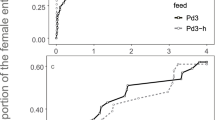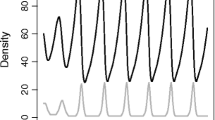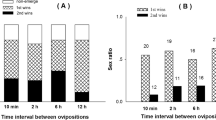Abstract
Approximately three decades ago the question was first answered “whether parasitoids are able to assess the number or origin of eggs in a host” for a solitary parasitoid, Leptopilina heterotoma, by fitting theoretically derived distributions to empirical ones. We extend the set of different theoretically postulated distributions of eggs among hosts by combining searching modes and abilities in assessing host quality. In the models, parasitoids search either randomly (Poisson) (1) or by vibrotaxis (Negative Binomial) (2). Parasitoids are: (a) assumed to treat all hosts equally, (b) able to distinguish them in unparasitised and parasitised hosts only, (c) able to distinguish them by the number of eggs they contained, or (d) able to recognise their own eggs. Mathematically tractable combinations of searching mode (1 and 2) and abilities (a,b,c,d) result in seven different models (M1a, M1b, M1c, M1d, M2a, M2b and M2c). These models have been simulated for a varying number of searching parasitoids and various mean numbers of eggs per host. Each resulting distribution is fitted to all theoretical models. The model with the minimum Akaike's information criterion (AIC) is chosen as the best fitting for each simulated distribution. We thus investigate the power of the AIC and for each distribution with a specified mean number of eggs per host we derive a frequency distribution for classification.
Firstly, we discuss the simulations of models including random search (M1a, M1b, M1c and M1d). For M1a, M1c and M1d the simulated distributions are correctly classified in at least 70% of all cases. However, in a few cases model M1b is only properly classified for intermediate mean values of eggs per host. The models including vibrotaxis as searching behaviour (M2a, M2b and M2c) cannot be distinguished from those with random search if the mean number of eggs per host is low. Among the models incorporating vibrotaxis the three abilities are detected analogously as in models with random search.
Experiments with two species of solitary parasitoids (L. heterotoma and Asobara tabida) are conducted. All theoretically postulated distributions are separately fitted to the resulting experimental egg distributions. The AIC criterion is used to choose the best fitting theoretical distribution. For both parasitoid species the frequency distribution of best fitting models for experimental data is compared to the classification of distributions generated by simulations. This leads to the conclusion that both L. heterotoma and A. tabida are able to distinguish between parasitised and unparasitised hosts. For L. heterotoma the results point to an ability to assess the number of eggs in a host, whereas A. tabida does not seem to have this ability. This difference suggests that an egg is more valuable for L. heterotoma than for A. tabida.
Similar content being viewed by others
REFERENCES
Akaike, H. (1974). A new look at the statistical model identification. IEEE Transactions on Automatic Control 19: 716-723.
Alphen, J.J.M. van and H.W. Nell (1982). Superparasitism and host discrimination by Asobara tabida Nees (Braconidae: Alysiinae), a larval parasitoid of Drosophilidae. Netherlands Journal of Zoology 32: 232-260.
Alphen, J.J.M. van, M.E. Visser and H.W. Nell (1992). Adaptive superparasitism and patch time allocation in solitary parasitoids: searching in groups vs sequential patch visits. Functional Ecology 6: 528-535.
Arditi, R. and O. Glaizot (1995). Assessing superparasitism with a model combining the functional response and the egg distribution of parasitoids. Entomophaga 40: 235-262.
Bakker, K., H.J.P. Eijsackers, J.C. van Lenteren and E. Meelis (1972). Some models describing the distribution of eggs of the parasite Pseudeucoila bochei (Hym., Cynip.) over its hosts, larvae of Drosophila melanogaster. Oecologia (Berlin) 10: 29-57.
Bakker, K., J.J.M. van Alphen, F.H.D. van Batenburg, N. van der Hoeven, H.W. Nell, W.T.F.H. Strien-van Liempt and T.C.J. Turlings (1985). The function of host discrimination and superparasitization in parasitoids. Oecologia (Berlin) 67: 572-576.
Bakker, K., P. Peulet and M.E. Visser (1990). The ability to distinguish between hosts containing different number of eggs by the solitary parasitoid Leptopilina heterotoma. Netherlands Journal of Zoology 40: 514-520.
Batenburg, F.H.D. van, J.C. van Lenteren, J.J.M. van Alphen and K. Bakker (1983). Searching for and parasitization of larvae of Drosophila melanogaster (Dipt.: Drosophilidae) by Leptopilina heterotoma (Hym.: Eucoilidae): a monte Carlo simulation model and the real situation. Netherlands Journal of Zoology 33: 306-336.
Carton Y., M. Bouletreau, J.J.M. van Alphen and J.C. van Lenteren (1986). The Drosophila parasitic wasps. In: M. Ashburner, H. Carson and J.N. Thompson (eds) “The Genetics and Biology of Drosophila”. Volume 3e. Academic Press London: 347-394.
Driessen, G. and L. Hemerik (1991). Studies on larval parasitoids of Drosophila: from individuals to populations. Ph.D. Thesis, University of Leiden.
Ellers, J. and J.J.M. van Alphen (1997). Life history evolution in Asobara tabida: plasticity in allocation of fat reserves to survival and reproduction. Journal of Evolutionary Biology 10: 771-785.
Galis, F. and J.J.M. van Alphen (1981). Patch time allocation and search intensity of Asobara tabida Nees (Braconidae) a larval parasitoid of Drosophila. Netherlands Journal of Zoology 31: 596-611.
Gates, S. (1993). Self and conspecific superparasitism by the solitary parasitoid Anthrocephalus pandens. Ecological Entomology 18: 303-309.
Hoeven, N. van der and L. Hemerik (1990). Superparasitism as an ESS: to reject or not to reject, that is the question. Journal of Theoretical Biology 146: 467-482.
Meelis, E. (1982). Egg distributions of insect parasitoids: a survey of models. Acta Biotheoretica 31: 109-126.
Visser, M.E., J.J.M. van Alphen and L. Hemerik (1992). Adaptive superparasitism and patch time allocation in solitary parasitoids: an ESS model. Journal of Animal Ecology 61: 93-101.
Weisser, W.W. and A.I. Houston (1993). Host discrimination in parasitis wasps: when is it advantageous? Functional Ecology 7: 27-39.
Author information
Authors and Affiliations
Rights and permissions
About this article
Cite this article
Hemerik, L., van der Hoeven, N. & van Alphen, J.J. Egg Distributions and the Information a Solitary Parasitoid has and Uses for its Oviposition Decisions. Acta Biotheor 50, 167–188 (2002). https://doi.org/10.1023/A:1016543310896
Issue Date:
DOI: https://doi.org/10.1023/A:1016543310896




